|
Key to Aquatic Plants
of Hawai`i
|
|
|

|
This key to the vascular aquatic plants (Embryophytes; plants other than algae, mosses, and liverworts) covers both ferns and seed plants. The key is artificial for the most part, meaning it is based largely upon descriptions of plant form (morphology) rather than comparisons of reproductive structures (which would actually determine how a plant is classified). It is, however, often necessary to have flowers and/or fruit present to confidently identify plant material observed or collected in the wild.
 Figure P7A. A variety of floating and emergent vascular plants grace the surface and margins of a small drainage canal at Kawai Nui (O‘ahu). Figure P7A. A variety of floating and emergent vascular plants grace the surface and margins of a small drainage canal at Kawai Nui (O‘ahu).
|
|
All species considered in this key are obligate [OBL] wetland species (USFWS, 1988) unless indicated otherwise as being facultative ([FAC] or [FACW]) or indicator status not determined [NI]. Typical riparian (streamside) plants that may or may not be wetland indicators are marked [RIP]. Species native to the Hawaiian Islands are classified as either indigenous [IND], endemic [END], or of early Polynesian introduction [POL]. Non-native species are either naturalized [NAT] or ornamental [ORN]. A listing of Hawaiian aquatic plants, arranged by taxa, is provided elsewhere in CPIE with additional information and links to photographs or descriptions for many aquatic or near aquatic species also provided.
If you are confident of the plant family for a specimen being identified, you may wish to jump directly to a starting couplet for that family:
CYPERACEAE | HYDROCHARITACEAE | LEMNACEAE | NYMPHAEACEAE
|
|
[VASCULAR PLANTS]
~~~~ ~~~~~~~~~~~~~~~~~~~~~~~~~
|
| |
70a
|
(24)
|
Entire plant a simple leaf or cluster of leaves, floating on
water surface and either lacking a stem or stem is present but short
and concealed in a whorl of leaves. Root or roots may hang beneath leaf or leaves
|
[71]
|
|
|
70b
|
|
Plant generally more complex, with leaves, stems, and roots, growing entirely submersed or mostly emersed (above water surface). Stem
may be long or short. Plant typically rooted into bank or bottom. If
floating on surface, then this is because stems rooted in bank have grown out over water surface OR roots and stems, attached to bottom, have
sent floating leaves to water surface
|
[74]
|
|
|
~~~~ ~~~~~~~~~~~~~~~~~~~~~~~~~
|
|
|
71a
|
(70)
|
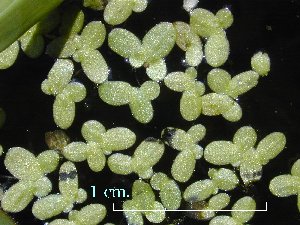
|
Plant a single, oval leaf or frond, or two to four simple
leaves attached wing-like together, these glabrous (without hairs) and under 1 cm across, growing in colonies on water surface. None, one,
or many unbranched roots attached to underside of each leaf. Usually on
still, fresh waters. Duckweed ~ Family LEMNACEAE
|
[85]
|
|
71b
|
|
Thallus several leaves arranged in a whorl, overlapping, or in pairs attached by stems. Leaves 0.2 cm to nearly 1 m long. Roots present or not, and branched or unbranched
|
[72]
|
|
~~~~ ~~~~~~~~~~~~~~~~~~~~~~~~~
|
|
|
72a
|
(71)
|
Leaves arranged along a horizontal axis, paired and crowded, each leaf under 2 cm across. Floating (true) ferns
|
[83]
|
|
|
72b
|
|
Leaves arranged on a vertical axis, forming a floating whorl or rosette; each leaf greater than 2 cm across
|
[73]
|
|
~~~~ ~~~~~~~~~~~~~~~~~~~~~~~~~
|
|
73a
|
(72)
|
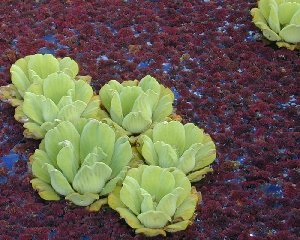
|
>
Leaves form a rosette, 3 to 12 cm across, pale green and
covered with a velvety pubescence (small hairs), grooved by
parallel veins, and internally spongy and thickened towards base.
{ Fresh or sl. brackish water ponds and canals. Water lettuce
~ Family ARACEAE Pistia stratiotes L.
|
|
73b
|
|
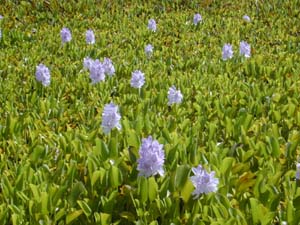 |
Leaves oval with inflated, spongy petioles, dark green and shiny to 60+ cm tall. Flowers showy, with violet petals (a yellow spot on uppermost petal) and clustered on a tall spike. { Fresh and brackish water ponds, reservoirs, and canals. Water hyacinth ~ Family PONTEDERIACEAE Eichhornia crassipes (Mart.) Solms
|
<
|
~~~~ ~~~~~~~~~~~~~~~~~~~~~~~~~
|
|
74a
|
(70)
|
Plant fully aquatic -- normally growing entirely submersed (below water surface) OR mostly submersed except for leaves floating on, or some leaves held above, water surface
|
[75]
|
|
|
74b
|
|
Plant is neither floating, nor entirely submersed; growth either substantially emersed (above water surface), or plant not growing directly in or on the water, but associated with wet places or the margin of a stream or pond (possibly riparian)
|
[94]
|
|
~~~~ ~~~~~~~~~~~~~~~~~~~~~~~~~
|
|
75a
|
(74)
|
Plant stem and roots submersed and attached to bottom, but some or all leaves either floating or held above the water surface
|
[76]
|
|
|
75b
|
|
Plant normally growing entirely or partly submersed, but if some leaves held above water surface, these identical in form to the underwater leaves
|
[77]
|
|
~~~~ ~~~~~~~~~~~~~~~~~~~~~~~~~
|
|
76a
|
(75)
|
Plant stem and roots submersed. Broad leaves borne on long stipes and floating on surface. Water lilies (Fig. 2, below)
~ Family NYMPHAEACEAE
|
[84]
|
|
|
76b
|
|
Some leaves on the same stem floating or held above water surface and some leaves always submerged, AND the submerged and subaerial (in the air) leaves distinctly different in form (dimorphic): the submerged ones very narrow, the subaerial ones broad and elliptic. Uncommon in ditches, ponds, and lo'i at low elevation. Long-leaved pondweed [IND]
~ Family POTAMOGETONACEAEPotamogeton nodosus Poir.
|
|
|
~~~~ ~~~~~~~~~~~~~~~~~~~~~~~~~
|
|
77a
|
(75)
|
Plant having leaves arranged in whorls at nodes along length of the stem, with 3 to 8 sessile leaves at each node. {Plant lax or stiff.
|
[78]
|
|
|
77b
|
|
Plant with grass-like or strap-like leaves; the leaves arising either from a buried rootstock or along a stem, and not obviously whorled on the stem. {Plant lax
|
[80] |
|
~~~~ ~~~~~~~~~~~~~~~~~~~~~~~~~
|
|
78a
|
(77)
|
Leaves dissected into filiform (thread-like) segments. {With or without roots |
[79]
|
|
|
78b
|
|
Leaves narrow but not cut in thread-like segments; entire, not forked. {Usually with some roots arising from lower nodes
~ Family HYDROCHARITACEAE |
[83] |
|
~~~~ ~~~~~~~~~~~~~~~~~~~~~~~~~
|
|
79a
|
(78)
|
Leaves forked once or twice. Plant without roots. Lowland marshes. Hornwort
~ Family CERATOPHYLLACEAECeratophyllum demersum L.
|
|
79b
|
|

|
Leaf segments feather-like, coming off a central axis. Plant rooted and usually growing above and below the water surface. Ponds, streams, taro lo`i, and marshes. Parrot's feather ~ Family HALORAGACEAE Myriophyllum brasiliense Cambess.
|
|
|
|
~~~~ ~~~~~~~~~~~~~~~~~~~~~~~~~
|
|
80a
|
(77)
|
Leaves strap-like, arising from a creeping rootstock
~ Family HYDROCHARITACEAE
|
[82] |
|
80b
|
|
Leaves thread-like to grass-like, stem thin and branching
|
[81] |
|
|
~~~~ ~~~~~~~~~~~~~~~~~~~~~~~~~
|
|
81a
|
(80)
|
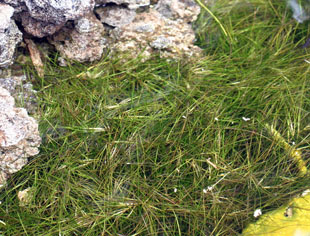 |
Narrow, linear leaves well-spaced or clustered, but having a broad, sheathing base. {stems branched and arising from a creeping rhizome. Occasional in coastal ponds and other brackish to saline waters. Widgeon grass or ditchgrass [IND]
~ Family RUPPIACEAERuppia maritima L.
|
[82] |
|
81b
|
|
Narrow linear leaves sheathing the stem or not, but if sheathing, not conspicuously broader than blade. {Stems much branched and arising from a dense mat of slender rhizomes. Rare in freshwater ditches and taro lo'i. Leafy and sago pondweeds
~ Family POTAMOGETONACEAEPotamogeton foliosus Raf. and P. pectinatus L.
|
|
|
|
|
Key to Family Hydrocharitaceae
|
|
82a
|
(80)
|
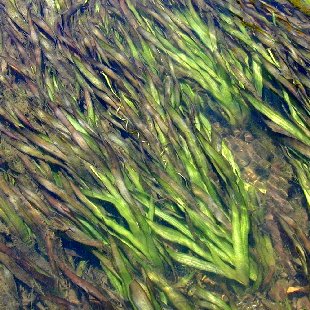 |
Plant entirely or mostly submersed and consisting of sessile, strap-like leaves that are 15-20 cm wide, and have rounded tips (when not torn or shredded); leaves arise from a creeping rootstock anchored (or buried) on the bottom. Female flowers borne on long, spiralling scape (flower stem). Cultivated in streams and naturalized in some areas. TapegrassVallisneria spiralis L.
|
|
|
82b
|
|
Plant similar, but leaves narrower and tips pointed. Aquarium plants [Fam. ALISMATACEAE] Sagittaria cf. subulata
|
|
|
~~~~ ~~~~~~~~~~~~~~~~~~~~~~~~~
|
|
83a
|
(78)
|
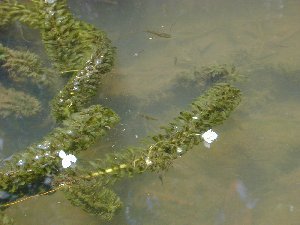 |
Leaves very dense on stem, obscuring it at least over terminal several centimeters, each leaf 15 to 30 mm long and 2 to 5 mm across. Flowers with three white petals, 8 - 10 mm long. { Streams and ponds. Elodea or anacharis Egeria densa Planch.
|
|
|
83b
|
|
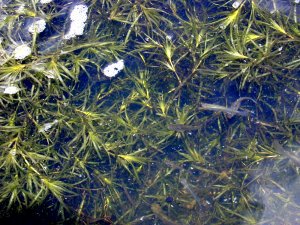 |
Leaves narrow, 8 - 40 mm long by 1 - 5 mm, not or hardly at all obscuring stem except at growing tip; nodes nearly as far apart as length of leaves. Flowers tiny, 2 to 3 mm long. Streams and ponds Hydrilla verticillata (L.) Royle
|
|
|
|
|
|